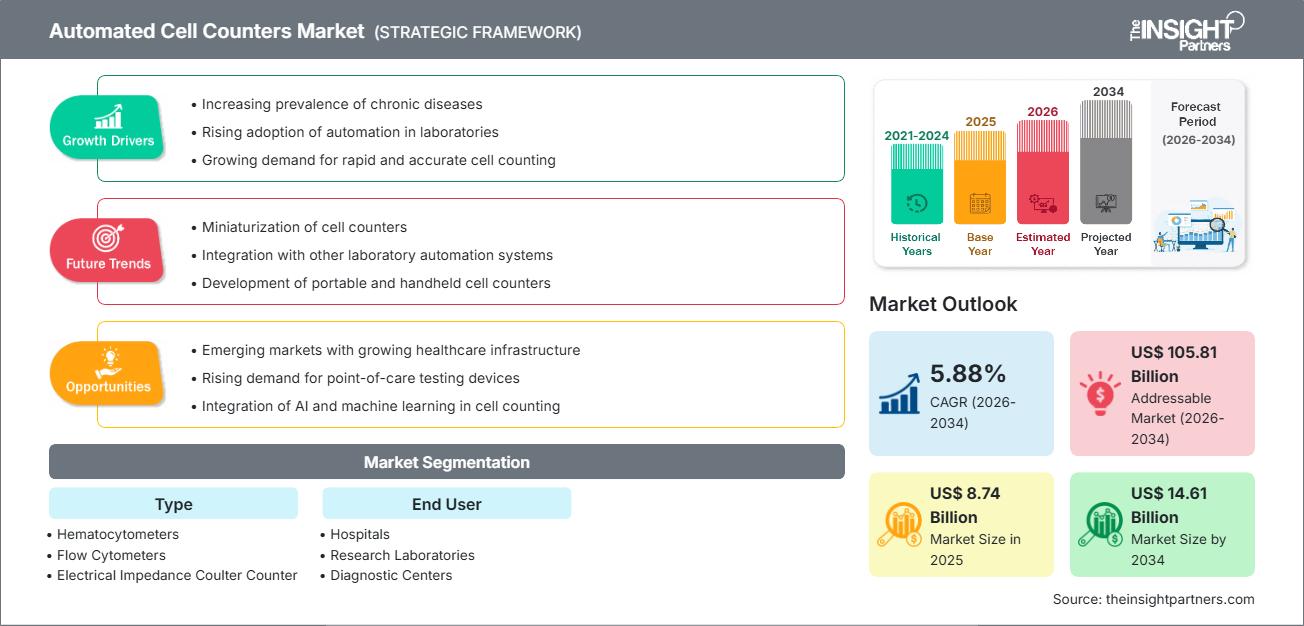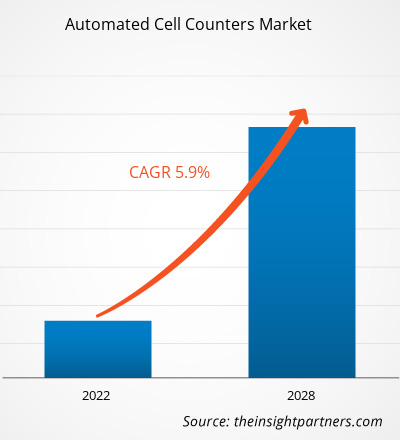预计到2034年,自动细胞计数器市场规模将从2025年的87.4亿美元增长至146.1亿美元。预计在2026年至2034年的预测期内,该市场将以5.88%的复合年增长率增长。
自动化细胞计数器市场分析
自动化细胞计数器市场预测显示,该市场将呈现强劲增长势头,主要驱动力来自临床诊断、学术研究以及蓬勃发展的生物制药行业对高通量、高精度细胞分析日益增长的需求。全球慢性疾病(尤其是血液肿瘤和传染病)的患病率不断上升,使得对能够高效处理大量样本并保持高精度的精密诊断工具的需求日益增长。人工智能 (AI) 和先进图像分析技术的融合等重大技术进步进一步推动了市场扩张,这些技术最大限度地减少了人为操作的误差,并提高了细胞活力和形态评估的精确度。全球范围内为实现标准化和缩短实验室周转时间而大力推广自动化解决方案,是推动市场增长的关键所在。
自动化细胞计数器市场概览
自动细胞计数器 (ACC) 是一种精密的实验室仪器,旨在精确量化和评估各种体液样本中细胞的活力,标志着对易出错的传统手动方法的重大革新。该系统采用多种技术,包括阻抗法、光散射法(流式细胞术)和图像识别等,可提供快速、客观且可重复的结果。ACC 系统在医院、专科诊断中心和合同研究组织 (CRO) 等主要医疗保健领域至关重要。其应用涵盖血液学中的全血细胞计数 (CBC) 的关键领域、癌症的精准诊断(例如白血病监测)以及生物加工过程中的关键质量控制,尤其是在干细胞和细胞疗法的生产过程中。ACC 解决方案通过提高工作流程效率和数据完整性,构成了高风险临床和研究环境的运营支柱。
根据您的需求定制此报告
您可以免费获得任何报告的定制服务,包括本报告的部分内容、国家/地区层面的分析、Excel 数据包,以及面向初创企业和高校的优惠折扣。
自动化细胞计数器市场:战略洞察

-
获取本报告的主要市场趋势。这份免费样品将包含数据分析,内容涵盖市场趋势、估算和预测等。
自动化细胞计数器市场驱动因素和机遇
市场驱动因素:
- 对高通量诊断和筛查的需求日益增长:全球人口增长、人口老龄化以及随之而来的患者数量激增,要求诊断系统能够快速准确地处理样本。自动化计数器通过实现连续、高速分析来满足这一需求,显著提高实验室效率,并减轻人工计数带来的行政负担。
- 细胞研究和生物制药生产的进展:再生医学、免疫疗法(例如CAR-T细胞疗法)和疫苗研发等相关研究活动的急剧增加,使得在生产过程的多个阶段进行精确的细胞计数和活力评估变得至关重要。自动化系统对于维持这些高价值生物制品的质量和一致性至关重要。
- 临床和研究实验室自动化转型:医疗机构正加速推进自动化技术取代主观性强、劳动密集型的手工操作方法。这一转变的主要驱动力在于提高标准化程度、增强结果一致性并减少人为误差,尤其是在时间紧迫的肿瘤和血液学检测领域。
市场机遇:
- 人工智能和机器学习的集成以实现更强大的分析能力:未来的增长轨迹高度依赖于人工智能和机器学习算法的集成。这些算法能够实现基于图像的高级分析、细胞类型的自动区分以及与细胞健康和功能相关的预测分析——所有这些都远远超出了传统计数方法的能力范围。
- 个性化医疗和液体活检领域的新兴应用:自动化计数器在个性化治疗方案和细胞疗法输送所需的精准监测中发挥着日益重要的作用。它们提供追踪治疗反应和确保患者安全所需的精确定量数据。
- 随着医疗基础设施的不断完善,新兴市场正在蓬勃发展:亚太和拉丁美洲等地区正经历着公共和私人对医疗基础设施和研究设施的大量投资。这种发展为自动化、高性价比的细胞计数解决方案创造了巨大的潜在市场,这些解决方案能够促进诊断能力的快速现代化。
自动细胞计数器市场报告细分分析
自动细胞计数器市场根据其底层技术(类型)和主要运行环境(最终用户)进行全面细分,以反映整个行业中多样化的应用和使用模式。以下是大多数行业报告中使用的标准细分方法:
按类型:
- 血细胞计数器(自动)
- 流式细胞仪
- 电阻抗库尔特计数器
- 分光光度计
最终用户:
- 医院和诊断中心
- 研究实验室
- 生物技术和制药公司
按地理位置:
- 北美
- 欧洲
- 亚太地区
- 南美洲和中美洲
- 中东和非洲
自动化细胞计数器市场区域洞察
The Insight Partners 的分析师对预测期内影响自动细胞计数器市场的区域趋势和因素进行了详尽的阐述。本节还探讨了北美、欧洲、亚太、中东和非洲以及南美和中美洲等地区的自动细胞计数器市场细分和地域分布。
自动细胞计数器市场报告范围
| 报告属性 | 细节 |
|---|---|
| 2025年市场规模 | 87.4亿美元 |
| 到2034年市场规模 | 146.1亿美元 |
| 全球复合年增长率(2026-2034 年) | 5.88% |
| 史料 | 2021-2024 |
| 预测期 | 2026-2034 |
| 涵盖部分 |
按类型
|
| 覆盖地区和国家 |
北美
|
| 市场领导者和主要公司简介 |
|
自动细胞计数器市场参与者密度:了解其对业务动态的影响
受终端用户需求不断增长的推动,自动化细胞计数器市场正快速发展。终端用户需求增长的驱动因素包括消费者偏好的转变、技术的进步以及消费者对产品优势的认知度提高。随着需求的增长,企业不断拓展产品和服务,创新以满足消费者需求,并把握新兴趋势,这些都进一步推动了市场增长。

- 获取自动化细胞计数器市场主要参与者概览
按地区划分的自动细胞计数器市场份额分析
预计未来几年亚太地区将实现最快增长。南美和中美洲、中东和非洲等新兴市场也为自动化单元计数器供应商提供了巨大的扩张机遇。
受医疗基础设施、监管环境、数字医疗普及程度和政府政策等因素的影响,自动化细胞计数器市场在不同地区的增长轨迹各不相同。以下是各地区市场份额和趋势概述:
北美
- 市场份额:由于拥有高度先进的医疗保健基础设施和对诊断准确性的强有力监管支持,因此占据最大的市场份额。
- 主要驱动因素:人均医疗保健支出高
- 趋势:人工智能图像分析和高通量流式细胞仪系统在临床病理实验室中的领先集成。
欧洲
- 市场份额:得益于强大的学术研究经费和公共卫生数字化项目,市场份额显著增长。
- 关键驱动因素:政府指令支持先进诊断技术
- 趋势:重点关注 ACC 系统与中央实验室信息管理系统 (LIMS) 的互操作性,以及在免疫疗法试验中日益增长的应用。
亚太地区
- 市场份额:增长最快的地区,这得益于医疗保健的快速扩张和生命科学研究投资的增加。
- 关键驱动因素:医疗旅游的增长
- 趋势:在新成立的诊断中心和小型诊所中,紧凑、经济高效的自动化阻抗和图像计数器得到了广泛应用。
南美洲和中美洲
- 市场份额:新兴市场,由于医疗基础设施现代化,具有增长潜力。
- 关键驱动因素:患者意识的提高
- 趋势:对可扩展、耐用的自动化血液分析仪的需求日益增长,这种分析仪适合资源不同的实验室。
中东和非洲
- 市场份额:新兴市场,受国家医疗保健投资战略的推动,具有强劲的增长潜力。
- 关键驱动因素:政府主导的国家电子健康战略
- 趋势:将先进的自动化计数器作为综合健康信息系统的一部分进行实施,通常通过国际合作来实现。
竞争格局及主要参与者 市场密度及竞争情况
自动化细胞计数器市场呈现适度整合的态势,少数几家全球行业领先企业之间竞争激烈,这些企业专注于技术差异化(尤其是在流式细胞术和图像分析领域)并不断扩大其地域覆盖范围。关键竞争因素包括细胞活力评估的准确性、分析速度、设备尺寸和便携性,以及仪器与实验室软件的无缝集成。
在这种竞争激烈的环境下,供应商通过以下方式实现差异化:
- 技术创新:开发结合阻抗和光学检测的多模态系统,以获得更优的数据质量。
- 软件与人工智能集成:利用机器学习增强系统,实现自动差异计数和质量控制检查。
- 战略合作伙伴关系:与大型生物制药公司和研究机构合作,以确保高通量计数器的长期供应合同。
在自动化细胞计数器市场运营的主要公司有:
- 赛默飞世尔科技公司
- 贝克曼库尔特公司(丹纳赫)
- F. Hoffmann-La Roche 有限公司
- 艾本多夫股份公司
- Bio-Rad Laboratories, Inc.
- Chemometec A/S
- Countstar 公司
- Nanoentek
- 对齐遗传学
免责声明:以上列出的公司不分先后顺序。
自动化细胞计数器市场新闻及最新进展
-
赛默飞世尔科技公司推出Countess 3系列产品。
赛默飞世尔科技推出搭载人工智能技术的Countess 3和Countess 3 FL全自动细胞计数器,采用机器学习算法,显著提升明场和荧光检测的准确性。这些计数器支持快速测量(<30秒),载玻片可重复使用,并符合美国联邦法规21 CFR Part 11的要求,适用于受监管环境。 -
Beckman Coulter, Inc.(丹纳赫)——Cydem VT 自动化克隆筛选
Beckman Coulter 推出了一款用于 CHO 细胞系开发的高通量系统,可自动完成克隆筛选中高达 90% 的手动步骤。 -
F. Hoffmann‑La Roche Ltd – Cedex 分析仪系列
Roche 推出了新的 Cedex Bio 和 Cedex Bio HT 分析仪,可为生物过程监测提供高通量细胞和代谢物分析(高达 300 次测试/小时)。
自动细胞计数器市场报告涵盖范围和交付成果
《自动化细胞计数器市场规模及预测(2021-2034)》报告对市场进行了详细分析,涵盖以下领域:
- 自动细胞计数器市场规模及预测,涵盖全球、区域和国家层面的所有主要市场细分领域。
- 自动细胞计数器市场趋势,以及市场动态,例如驱动因素、制约因素和关键机遇。
- 详细的PEST和SWOT分析。
- 自动细胞计数器市场分析涵盖关键市场趋势、全球和区域框架、主要参与者、法规和近期市场发展。
- 行业格局和竞争分析,涵盖自动细胞计数器市场的市场集中度、热力图分析、主要参与者和最新发展。
- 公司详细简介。
- 历史分析(2 年)、基准年、预测(7 年)及复合年增长率
- PEST和SWOT分析
- 市场规模、价值/数量 - 全球、区域、国家
- 行业和竞争格局
- Excel 数据集
近期报告
客户评价
购买理由
- 明智的决策
- 了解市场动态
- 竞争分析
- 客户洞察
- 市场预测
- 风险规避
- 战略规划
- 投资论证
- 识别新兴市场
- 优化营销策略
- 提升运营效率
- 顺应监管趋势






















 获取免费样品 - 自动化细胞计数器市场
获取免费样品 - 自动化细胞计数器市场